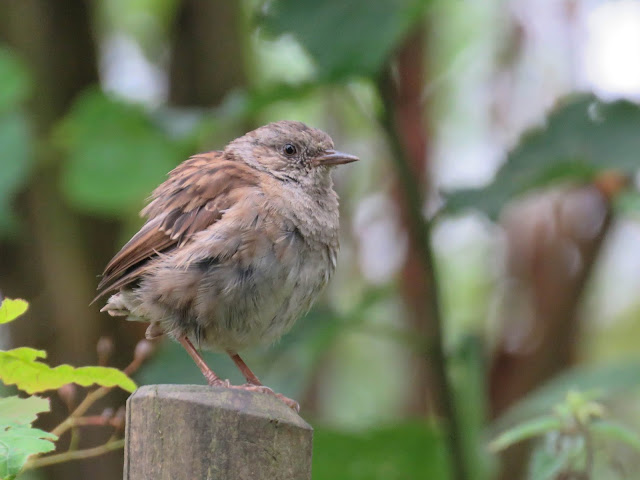Just the three of us for this month's Axarquia Bird Group visit to the Guadalhorce at Malaga with Linda Pheasant and Mike Kinchington joining me on our quest to see if the visiting Pacific Golden Plover was still gracing us with its presence. Lots of local House Sparrows about upon arrival and no shortage of Sardinian Warblers as we made our way to the footbridge. No sooner had I entered the bridge than I saw a Kingfisher fly low across the water to the far bank and, at the same time, A single Little Egret up stream and what looked like a dreaming Grey Heron on the eastern bank downstream. Both Barn and Red-rumped Swallows in the air above us, but very few in number, and, naturally, an assortment of the resident Rock Doves/Feral Pigeons resting under the motorway bridge.
Making our way towards the eastern arm a small flock of Spotless Starlings passed over and, in the distance more Sardinian Warblers and a handful of Goldfinches feed on the track. Having already recorded Pallid Swift we now seemed to see more Common Swifts above us and fairly regular passages of passing Lesser Black-backed Gulls. At this point we also got our first of the morning fly-pasts by the local, raucous, marauding Monk Parakeets.
 |
| Distant Dunlin Calidris alpina with Little Ringed Plover Charadrius dubius |
Arriving at the Laguna Casillas there seemed to be very little bird life other than the very good number of Coot. But then a single Moorhen and the sight of at least five Mallard and a couple of Little Grebe. Later, it would appear that the grebes also had a couple of youngsters. The Little Egret arrived to feed away to our left and a very voluble Cetti's Warbler announced its presence.
 |
| Lots of juvenile Little Ringed Plover Charadrius dubius on the wader Pool |
Next to the Wader Pool with a Hoopoe crossing the track in front of me and, fingers crossed, the target bird, a rare visiting Pacific Golden Plover, might still be on site after two weeks or more. No such luck, looks like the bird knew I was on my way and decided to move on before my arrival! Lots of Little Ringed Plovers on the "beaches" and thirty Black-wing Stilts counted. The juvenile Lapwing was still present and, in addition, we managed to find a couple of Dunlin as well as the odd Ringed Plover.
 |
| Juvenile Lapwing Vanellus vanellus with Black-winged Stilt Himantopus himantopus |
A considerable time was spent at this hide checking every nook and cranny and patiently awaiting our special bird if it was still on site. Collared Doves came and in the far distant trees we had both a resting Purple Heron and a pair of Peregrine Falcons. Shame the latter moved as soon as I raised the camera, even if it would have been a distant shot of maybe 200 metres. Having duly noted the newly-arrived Greenshank we moved on to the nearby old river, Rio Viejo, passing a small flock of Greenfinch on the way.
 |
| A very distant resting Purple Heron Garza Imperial Ardea purpurea |
I've heard of people fainting with excitement but the discovery of the Pacific Golden Plover seemed to coincide with something wrong with me. Both Lindsay and Mike were able to zoom in on our bird but I certainly now felt the worse for fair with what seemed a dizziness and very uncomfortable feeling in the stomach. So bad, I did not even feel strong enough to actually try for a record photograph but rather sough a tree against which I could rest. End result, Lindsay helped me back to the hide so I could sit and recover but having come across a visiting warden he agreed to take me back by car to the entrance. So ended my morning and after a short rest I made my way back to Mezquitilla. Much better now and can only put it down to, perhaps, tiredness, lack of sleep following a late night and early departure this morning.
Meanwhile, Lindsay and Mike stayed on for a little longer and were pleased to observe a pair of Kingfishers, presumably at the Laguna Escondida. So many thanks to Mike and Lindsay for their company and support and here's to next time - but without the little trauma!
 |
| If only the camera had been ready ten seconds earlier and you would have seen a true pair of Peregrine Falcons rather than this Collared Dove Streptopelia decaocto |
Birds seen:
Mallard, Little Grebe, Little Egret, Grey Heron, Purple Heron, Peregrine Falcon, Moorhen, Coot, Black-winged Stilt, Little Ringed Plover, Ringed Plover, Kentish Plover, Pacific Golden Plover, Lapwing, Curlew Sandpiper, Dunlin, Greenshank, Lesser Black-backed Gull, Rock Dove, Collared Dove, Monk Parakeet, Common Swift, Pallid Swift, Kingfisher, Hoopoe, Barn Swallow, Red-rumped Swallow, Cetti's Warbler, Sardinian Warbler, Spotless Starling, House Sparrow, Greenfinch, Goldfinch.
Check out the accompanying website at http://www.birdingaxarquia.weebly.com for the latest sightings, photographs and additional information

















































